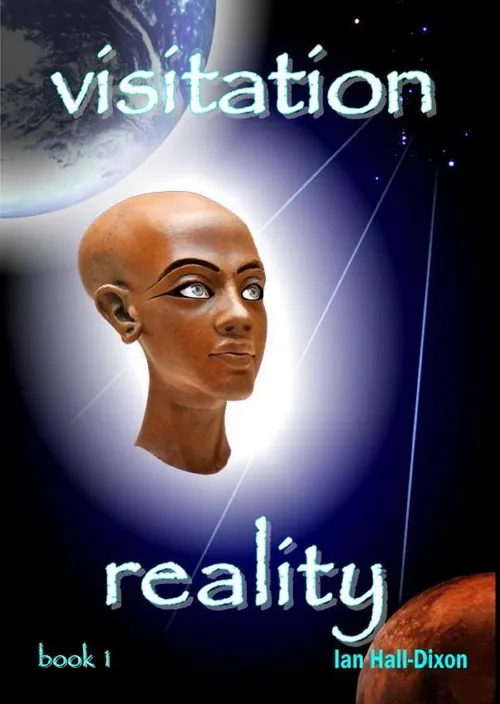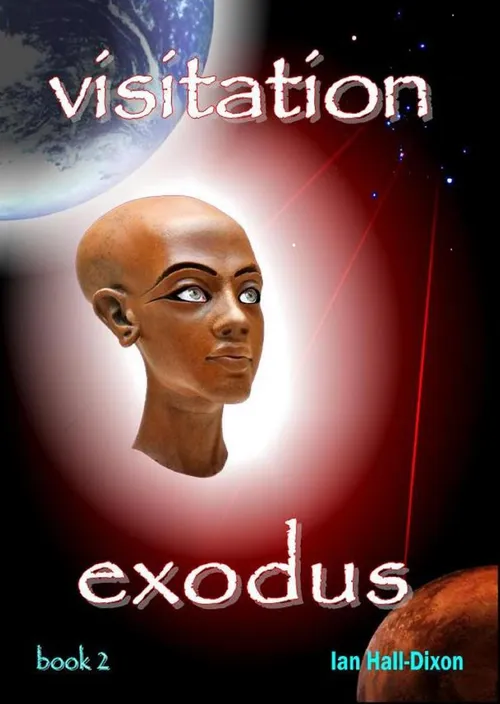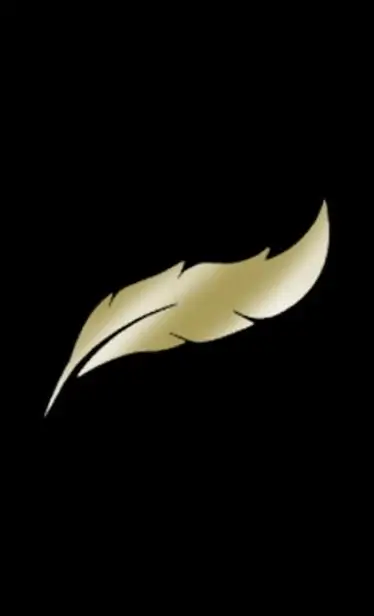THE ANCIENT TALES
NORALM STARED EVEN more intently through his eyepiece of his great telescope. It was located at the highest altitude on top of the planet's tallest mountain. This was almost at the edge of the breathable atmosphere and Noralm, unusually for him, was having some difficulty focussing through the lens because of the obligatory breathing apparatus he was wearing.
He had not made a visual sighting yet that could confirm what the electronics elsewhere were telling all in the scientific world. It was essential that he, as the planets top astronomer could confirm as quickly as possible that the detected intruder was actually there and was as large as the models were predicting. This sort of information could not be released to the general population until confirmed by him and his team and even then, it may be too dangerous to do so.
There had been a panic in scientific circles for several days now, as the automatic instruments and self-determining computers had been generating warning messages. They had, of course, been programmed for all eventualities many hundreds, some say thousands, of years ago although the complete range of possible alarms and printouts was simply unknown. The computers may be issuing a pre-emptive warning, a 'take a look and see for yourself' message or it might only be advice on a forthcoming event that may have a critical element of risk about it. Because of the perceived ambiguity, it had been referred back to Noralm for a confirmatory visual search.
Whoever had programmed the self-determining computing equipment, way back, had known what they were doing. As many of the ancient records had been lost long before Noralm and his fellow scientists had even been conceived, nobody currently knew the full extent of the global system’s potential. For many years now, great reliance had been placed on this archaic yet fully functioning computing system to predict the movements of all the planets in this system and, as far as anyone could tell, detect all the asteroids that, from time to time, still entered the orbits of the planets on their journey round the great life giving sun.
This had proved particularly useful when it had been determined that the exploration of the nearest planetary neighbour was to get under way at last. It had been found to contain, not only similar vast amounts of water as here at home, but also an atmosphere that supported a great range of life in the form of both flora and fauna remarkably similar to that existing on this planet.
Great interplanetary ships had been built to carry a full scientific exploration to the neighbour and had been declared a great success.
Discoveries had been made of the existence of hominid forms, not too dissimilar, genetically, to themselves although with many generations still to travel to achieve a similar degree of development.
They were in the early stages of the evolutionary path, walked upright, were generally co-operative with each other in the same group, lived in small communities, hunted for food (disgustingly of the living kind) and had a basic sort of communication.
Full-scale expeditions were planned for a major re-visit when the news broke. All attention was now focussed on what had been announced (within the scientific community and to the planet’s leadership) of a life-threatening intruder into this planetary system.
“I’ve found it,” Noralm shouted through his breathing mask and as he locked the giant scope onto the faintest of light spots that anyone else would have been unable to see.
“Give this beast an hour and we will have the confirmation or otherwise of what the giant detectors are saying, hopefully it will be in the ‘negative’; they’re not infallible you know.”
He was whistling in the dark, as all round him knew the detectors had never been proved wrong. The news of the very existence of the planet being in dire peril, nobody was prepared to accept or announce without Noralm's confirmation.
“There is a myth, Noralm,” up spoke his colleague Devor through his breathing equipment, “that says we are a race who will be hunted for eternity and that every many thousand years we will again be put to the test. Perhaps this is to be another of the tests.”
Devor was simply verbalising the ancient mythical story taught to children at kindergarten. No-one knew any more where it had originated but it was said to be a very ancient saying lost somewhere in the myths and mists of time.
“I’ve heard that nonsense before,“ he snapped back, “This is the kind of thing suitable only for nursery schools or science fiction writers.”
“But Noralm, why are we exploring our neighbouring planet if we have no need, we have a good existence here? Is it not because it is within our DNA to always search and explore for new places, possibly for good reason? The Genome Institute announced only last year that they had identified the particular strands of DNA responsible for this seeking habit.”
“Noralm was having none of this, he was a hard-nosed physical scientist and the pressure of the current situation was beginning to tell.
“If I hear any more of that clap trap from anyone, they will be banned permanently not only from my station here, but from my team, is that understood?”
In that mood, no one dared to query him further, not even a close colleague such as Devor.
This was occurring at the same time as some of the most ancient writings, recently discovered in earthenware jars buried in the shade of a mountain, were starting to reveal amazing stories of exploration, piece by piece, as they were deciphered.
The presence of human kind here on this wonderfully rich and bountiful planet was being described within the writings to be not a product of natural selection, as the geneticists would have it, but from some ancient ancestors who survived an enormous journey, from somewhere in the stars, to arrive tens, possibly hundreds, of thousands of years previously.
The name Sirius had twice been found in the deciphered texts although one had crumbled (or was deliberately smashed, so the rumour went) before all could be read or even recorded in their original form.
The public knowledge of the discovery and some of the content had been broadcast round the world by the media and had everyone’s attention for the present.
The ramblings of the old seers with their prophetic messages, might actually be considered to have some substance now, but the intellectuals undertaking the preservation and translation work were being heavily criticised by the ‘solid’ scientific community as a result. Mentioning such work, here in this circle of Noralm, risked everything; better to stay quiet.
Less than an hour had passed when the calculations had been performed by the computer that was tracking the object identified by Noralm, way out at the farthest reaches of the solar system. It was beyond the outer asteroid belt, but capable of detection from its size and by reflection of the solar light, infra-red spectrums employed by this telescope. Combined with Noralm's skill from a lifetime of detailed work, very definitive answers were expected to be forthcoming.
The information that had been processed by the ‘on-board’ systems of Noralm’s telescopes was transmitted to the much bigger processing facility at the centre.
This was not automatically linked to the global system to ensure independent analysis, if that was possible, considering its size and complexity.
The bigger processing centre had the answer within two minutes; the global system was confirmed as correct in its notifications. The object was on a trajectory, dipping initially below the ecliptic plane, but then curving back in to the point of a predicted crossing with the planet's orbit. This small planetary sized object would, within two years, not only cross the orbit but strike somewhere in the southern hemisphere, perhaps just a glancing blow, perhaps not, but enough to cause untold destruction and the extinction of all life.
The explosion across the skies from such an impact was predicted to burn away the entire atmosphere, remove all the water that filled the sweet lakes and the clouds of the skies would almost certainly boil off into space. The atmosphere would be substantially lost. The debris thrown up by the impacting explosion would decimate anything standing in the northern hemisphere; the southern hemisphere was simply to be declared as ‘lost’.
Survival in the depths of the planet's crust, where water from the great lakes was stored naturally in great caverns and also through which the communication infrastructure systems ran, was to be a hit and miss affair.
The shock wave through the ground may rip them apart, the associated breathing and water transit systems completely malfunction and all life present at the time be extinguished. What had not been properly calculated yet was the exact nature of the mass coming towards them and the precise effects the impact may have.
In the best-case scenario this was a lightweight object, relatively speaking, whose collision would still cause significant surface damage as computed but, possibly, not massive enough to destroy everything below the surface to the north. In the extreme worst case, the entire planet may be transformed into a molten mess of rock but this was more the product of frightened minds than predicted reality. Further calculations from the linking of the Noralm processing centre to the global system were awaited.
Noralm finally received the news, still standing at his telescope, in abject fear, his body trembling at the implications. The sweat ran uncontrollably down his face inside of his breathing device. The suffocating effect of this only added to the terrible mixture of the fear and anger that he now felt.
“This has to be a complete nonsense,” his trembling voice managed, “I must have picked up the wrong spot of light. My eyes are not as good as they used to be.” He was fabricating whatever words would come to him.
Incorrectly and because of his personal arrogance, he interpreted the result as, somehow, losing face before his team and junior colleagues. He had carried out the visual sighting with his telescope, had it computed and correlated by his system, and would have to transfer the data, with his personal attributes, onto the global system.
He considered that blame for providing such bad news would, somehow, be apportioned entirely to him and that he would have no control over this. He could not tolerate losing control of anything nor had he done so throughout his career, until now.
With a sense of desperation he dare not let the others realise, he looked again.
This time he spent nearly another hour ensuring that the comparative images did indeed indicate and confirm as correct, what he had first seen as a dim reflection through the infra-red filters of a minuscule moving point of light. He let the scope again do its computing having locked on to this point of feint light again.
The team re-assembled behind him, were daring to shuffle their feet and were clearly anxious and worried, but dare not move nor make any noticeable noise in any sort of significant manner.
One young woman, Caterin, who was stood to the rear of the assemblage had done an in-depth analysis of the global computing system as part of her Master’s Degree thesis. She knew from what she had gleaned of the system’s peripheral sections (the core system had never been capable of analysis, even by other computers and continued to remain a mystery) that it did not make mistakes.
She dare not move away or her career would be finished for certain and quietly let the tears run down her cheeks within her breathing equipment. Then in a moment of lucid realisation, she knew that this was no longer of any importance.
The survival of the world’s population was far more important than a career that within two years was about to be extinguished permanently anyway. Death was coming to all, including her and all who stood with her.
“You arrogant bastard,” she cried out in a flood of tears and sobbing muffled by her breathing apparatus, ran from the room and from Noralm’s team for good.
It was not long before the confirmations were completed and newscasters were announcing the message round the world; TV programs cropped up by the hour trying to analyse what it all meant. The bottom line was coming out the same, global death and destruction that could not be avoided.
The ancient stories, backed up by those of the ancient texts that had been deciphered, told of a race of people whose solar system, not too unlike this one, had also been about to disappear as its star was on the point of transformation, it seemed, into a red giant.
A lot of this was in-filled by speculation but the storyline ran consistently the same. Major space travel was already possible, albeit on a limited scale, but not as might be envisaged by whatever the ancients may have used, if the stories were to be believed. Somewhere over the many centuries the ancient engineering must have been lost, or hidden or something else even.
What had happened to the spacecraft that must have brought the ancestors to this home planet, if the stories were correct, had to remain a mystery. The world was now alight with a thousand different stories, speculations and myths as to how people had come to exist here. The impending loss of all life had sparked considerations previously kept below the surface or in fanciful stories.
The 'ancients' became the only topic for conversation.
If they really had existed then would they know of the impending doom and come to the rescue, was their technology for space travel somehow being kept secret but would suddenly appear to take everyone away to safety, and so on?
The consensus seemed to be that they must have constructed a major people carrier, a ‘Great Ark’ that had carried perhaps some many thousands of people and all the DNA of all the species of their world, at speeds useful for the distance between the stars.
This had to be how all living things on this planet had come into existence. The theories abounded in the popular imagination but not a shred of physical evidence could be found to substantiate any of them, except, perhaps the words of the scrolls.
If the ancients had built and employed such a Great Ark then, it was assumed, the propulsion systems must have been similar to those currently in use here in the local planetary craft and also in the interplanetary ships recently returned from the neighbour; anti-gravity types that relied upon space-time displacement.
The ancients must have travelled at tremendous speeds, again if the stories were to be believed, approaching a fraction of but never getting close to, the speed of light for the distances believed to have been travelled by them. This was still all speculation but a thread of truth seemed to exist somewhere in all the considerations.
The current technology was good, but it was not that good. It had been the subject of some development over the years as there was no evidence of anything that may have been left behind of any great scale by these ancients.
The propulsion systems used now were developments from items way back in history and were seen as the pinnacle of design, in principal at least, with refinements that may come if the ancient stories were to be believed.
The systems were inherently safe and incredibly gentle to the occupants, who had no sensation of movement, as a result of the so-called space displacement process. The space-time of the crafts' surroundings had been found capable of 'displacement' by major advances in scientific engineering providing lift (as might the earlier fixed wings of aircraft in the atmosphere) or directional thrust in whatever direction was required. The passengers within the craft being 'displaced' by the same process felt no sense of relative movement or inertia.
The amount of information being fed to the public of the impending disaster, from those in the know and from the whistle-blowers was tremendous; why hide everything when for most people their lives were destined to end. Noralm was a broken man and never left his magnificent observatory right up to the moment of impact nearly two years later as predicted.
The world government stepped in immediately, as the news was released generally and officially to the masses, and acquired the two great exploration ships that were permanently in orbit. They had recently returned from the neighbouring planet and were being prepared for further exploration but were now to be converted into mass transit ships. This would allow as many people and as much equipment as humanly possible to leave the planet to head to the neighbour where the chances of survival, though perhaps not on such a pleasant basis as at home, was reasonably good.
Those that had been selected to go would become pioneers. Survival of the greater part for the greater good became the key phrase. The work of conversion would take another year but that would be sufficient.
The concept of a Great Ark had been picked up from the ancient deciphered writings although what may have happened to the original ship, or ships if it or they existed at all, still remained a mystery.
Everyone in the world was given equal opportunity, by the global computer, to be one of the lucky chosen few selected to be a pioneering survivor. What they did not know was that those in government, and a few wealthy others, had attempted to programme a bias into the selection process so that particular people, of their own kind, were more likely (certain) to be selected to the detriment of others.
What these alleged leaders also did not know, however, was that the global computer had already been pre-programmed in ancient times for this possible eventuality. It selected, from the mammoth records (everybody’s life history was constantly recorded and updated in the computer database from birth to death including a track of their life’s progress) those it considered the most appropriate for the survival of a colonising force.
A mixture of engineers, builders, educationalist, survivalists, and soldiers, some from the practical side of science and many ordinary people were selected.
Caterin, the angry young lady scientist was amongst the first of the names to be announced for the first wave. She did not question why, there would be no point, but was incredibly grateful to the global computer system.
Only two of the current leaders were considered appropriate and the global computer not only issued a warning about attempting to alter this selection, it also made available world-wide through the common media systems, the list of those chosen.
The computer took control of all local transit crafts, many of which would be stowed aboard the New Arks, as the converted exploration ships were now being called, for use after arrival at the neighbour.
Immediate partners and spouses were included in the final list, with their children, if younger than twenty years of age, but with older offspring not so.
Many places were refused by those selected, as matters of conscience, and this provided more places for others. The global computer had no problem coping with this.
In all, it was intended that there would be as many waves as possible, with both ships holding roughly ten thousand persons each. The New Arks, the great ships of pioneering survivors, were to be pre-programmed to return automatically as soon as the last person had left on the transit craft for the surface of the neighbour.
It was calculated that at least two trips might be achieved with some twenty thousand in total for each successful escape. Depending upon the final path and speed taken by the intruder, a further trip might be possible.
For the remainder, the great bulk of the world's population, plans were started where a mass exodus of those from the southern hemisphere, where the impact was predicted to occur, would move north to the big underground transit and water holding areas. These were being modified, with the provision of life support systems and blast protection doors wherever possible to provide whatever protection that could be achieved when the impact came. Within six months, the works were sufficiently advanced to start the move.
The biggest delays in the exodus process were occurring in taking people from the surface up to the waiting orbiting spacecraft, the New Arks. They almost resembled asteroids with their massive protective shells of light grey impact material.
There were a limited number of access points and it took nearly a month’s hectic work to undertake the first loading.
The flight across the solar system would be problematic in that this planet and its neighbour were the farthest apart they could be. At the available speed of travel, as good as it was, this journey could not be achieved in less than two months. Then a further month would be required to disembark all the passengers, the supplies of food and equipment, the temporary survival housing and the precious DNA banks, which were considered the most important cargo of all.
The transfer craft stowed on board would be fully employed ferrying people and stores to the surface and some would remain there to await the next round trip of the New Arks, if this could be achieved.
A site high up in the mountains on the neighbour was chosen away from the wild beasts and the primates that roamed in the jungles below. The air was clear and fresh in this location and most breathable; it would also serve as a place unlikely to be discovered well into the foreseeable future. Having unloaded the final tranche of pioneers, the New Arks would return home automatically, a journey of another two months or so.
As the second trip was being readied to leave, the intruder having been well studied was now highly visible in the southern daytime sky and approaching fast.
It had a mass reading that said it was not anywhere near as dense as originally anticipated and that the point of impact would be more of an indirect blow although none-the-less devastating in its effect.
A precise location in the southern hemisphere, exactly as the first global computer calculations had originally predicted, was now known.
As this second flight got under way, on the ground the vast underground chambers and tunnels were filling to almost bursting point with people and provisions.
Water would not be a problem as this is where much of the drinking water was stored normally, in the cool dark caverns.
The impact occurred as the second flight had reached and was still unloading at the neighbour; a further attempt at another trip never took place. The resulting bright crimson light was seen clearly across the solar system and those watching on the craft and on the neighbouring planet wept as their home civilisation was most certainly disappearing forever with millions upon millions of people killed.
As predicted, the atmosphere was burnt off in the tremendous explosion, as was the surface water by blast and evaporation. A gigantic creator was created in the south where the deposition added greatly to the thickness of the crust.
Millions of tons of old and new, rock hurled across and round the planet at unimaginable speeds in a supersonic wind. The shock waves were stronger than anticipated and millions taking shelter close to the equator died instantly. Of those furthest away, many survived but only where the chambers were deepest.
Hardly a building or monument remained intact in the north, except for a few of the very old and enormous megalithic structures, built it were believed, by those ancients recently given credence just before the catastrophe struck. The millions of fragmented pieces of hot rock, that were not deposited in the south or crashed into the northern surface, bounced back into space to form, eventually, a new inner asteroid belt circling round the sun.
The magnetic poles, with their protective, radiation-shielding effect, were knocked out completely by the impact. The surface became bathed, as a result, in deadly ultra-violet light and cosmic rays. A charged solar wind penetrated what was left of an atmosphere, a hot burning thin image of what had previously existed, and any unprotected life left on the surface simply died.
It seemed the ancient texts were correct; these were a people to be hounded by events that would constantly have them on the move for their survival as a species.
Wherever they had come from those many thousands of years ago, the need to explore and move on to colonise new places was indeed in the DNA and the neighbouring survivors now knew why.
A star by the name of Sirius, close to the constellation of Orion, and even one of the other stars in that constellation, were the popular choices for where home was supposed to have been, but this was on the basis of ancient texts whose decipherment had barely started before all was lost with a guesswork that was no longer relevant.
The escape craft, the New Arks, as they were programmed to do, returned automatically to orbit the home planet awaiting further loading as soon as all had disembarked; it was not possible to interrupt the pre-programming.
Further loading never came, as it was now too late; there was nobody left to leave on another journey, so they continued in orbit without interruption.
All on the planet seemed destroyed forever, and the conditions for life had long since ceased to be. An atmosphere too thin, the surface bathed in ultra-violet light and bombarded with cosmic rays due to the lack of a weakened and still weakening magnetic field, resulted in nearly all the surface water being blown away or vaporised in the low atmospheric pressure and just about all infrastructure 'wiped' off the face of the northern hemisphere.
The surface 'hot' with cosmic rays had also become very 'cold' due to the loss of the greater part of the atmosphere. Nearly all the ground remaining in the layers near the surface, became frozen in the thin deposition of sand and dust. The ice of the north polar cap just survived as a fraction of what it had once been; the southern polar ice was simply gone.
The southern hemisphere was now obliterated and buried deep buried beneath kilometres thick of new hot rock. It resembled the planet, as it had been many millions of years previously. The surface of the rest of the planet likewise resembled an early planet with the surface soils stripped to reveal craters and rough rocky features.
There were survivors, in the north, but not that many. They sheltered deep in the underground caverns, reservoirs and transit system but only in areas well away from the equatorial regions.
These people were in scattered locations but had managed to make some contact with each other and in a tenacious bid for survival, started the first steps to make good what they still possessed and to live underground for many generations to come.
A story, a myth, started that those who had left for the neighbour, that was not too far away, would return eventually to rescue them.
And so they probably might have done if the New Arks had not returned automatically to park themselves in orbit. The myth of returning rescuers persisted for many generations and passed into the folklore of a peoples decimated by tragedy and the hardship of survival within the deep caverns.
The ships that may have taken them away, to join the those who had escaped to the neighbour, were now circling in low orbit awaiting commands that would never come. Transit ships that had been on the surface waiting to be used before the catastrophe, now lay as fragments within the thousands of scattered piles of rubbish.
A few attempts were made by a few hardy individuals in hurriedly assembled airtight suits to reach one of the remaining craft that had been spotted. They made the journey, to find it damaged irreparably, and in turn succumbed to the deadly cosmic rays and cold in complete despair. It was decided that no one would attempt such a rescue attempt again.
Those suits that had been available for survival in the depths of space, had travelled to the neighbour in the first explorations and then in the exodus process. Even they had not really been needed as the New Arks and transit craft had all the survival systems needed. Suits had been a precaution to be employed, if need be, on the neighbour. They had not been needed and had been stowed away there or in the ships, out of reach permanently by the survivors at home.
The grim reality of survival on the home planet became the only concern now. Myths and stories would suffice to keep moral up but all knew that this was to be a hard grim slog. Perhaps many generations later the myth might have some substance, but not for the present.









This story has not been rated yet. Login to review this story.